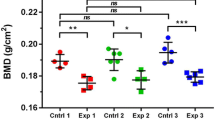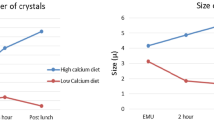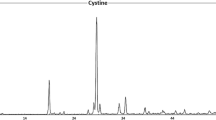Abstract
This study was aimed at investigating the impact of varying concentrations of strontium (Sr) on calcium (Ca) excretion via the urine and determine its impact on kidney stone formation. Twenty adult male Sprague Dawley rats weighing between 200 and 300 g were selected. The rats were randomly divided into four groups of five. One group was used as a control group while the other three groups were experimental. The diet of the rats was modulated over a 12 week period to investigate the impact of Sr on the urinary excretion of Ca. Urinary samples were collected every 2 weeks from the rats. The rats were fed water ad libitum. After the study the rats were euthanised and their kidneys harvested. Urine and kidney samples from the rats were analysed using Total Reflection X-Ray Fluorescence (TXRF). In the urine excretion of Ca increased with increased intake of Sr in the diet. Sr excretion via the urine also increased with increased dietary intake. There was a correlation of 0.835 at the significance level of 0.01 between Ca and Sr in the urine. However, for the kidneys, the varying concentration of Sr did not impact the retention of Ca in the kidneys. There was increased retention of Sr in the kidneys with increased dietary intake. In this study an increase of Sr in the diet resulted in an increase in urinary excretion of Ca.




Similar content being viewed by others
Data availability
The datasets generated and/or analysed during the current study are not publicly available due to it being a part of an ongoing PhD study but are available from the corresponding author on reasonable request. The data will be made public at the completion of the PhD dissertation.
References
Walker DC, Antoine JMR, Williams JA, Grant CN, Voutchkov MK (2021) Elemental investigation of renal calculi in Jamaica by instrumental neutron activation analysis (INAA). J Radioanal Nucl Chem 331(1):547–558. https://doi.org/10.1007/s10967-021-08071-6
Ticinesi A, Nouvenne A, Maalouf NM, Borghi L, Meschi T (2016) Salt and nephrolithiasis. Nephrol Dial Transplant 31:1. https://doi.org/10.1093/ndt/gfu243
Ramaswamy K, Killilea DW, Kapahi P, Kahn AJ, Chi T, Stoller ML (2015) The elementome of calcium-based urinary stones and its role in urolithiasis. Nat Rev Urol 12(10):543–557. https://doi.org/10.1038/nrurol.2015.208
Singh VK, Rai PK (2014) Kidney stone analysis techniques and the role of major and trace elements on their pathogenesis: a review. Biophys Rev 6(3–4):291–310. https://doi.org/10.1007/s12551-014-0144-4
Słojewski M (2011) Major and trace elements in lithogenesis. Cent-Euro J Urol 64:2. https://doi.org/10.5173/ceju.2011.02.art1
Blaschko SD, Chi T, Miller J, Flechner L, Fakra S, Kapahi P, Kahn A, Stoller ML (2013) Strontium substitution for calcium in lithogenesis. J Urol 189:2. https://doi.org/10.1016/j.juro.2012.08.199
Naveen J, Ashok K, Anupama M (2016) Role of strontium in biological system. Eur J Pharmaceut Med Res 3(12):177–184
Public Health Statement: Strontium (2004) In atsdr.cdc.gov (CAS#: 7440-24-6). ATSDR Department of Health and HumanServices, Public Health Service. Agency for Toxic Substances and Disease Registry. https://www.atsdr.cdc.gov/ToxProfiles/tp159-c1-b.pdf. Accessed 17 Oct 2022
Kołodziejska B, Stępień N, Kolmas J (2021) The influence of strontium on bone tissue metabolism and its application in osteoporosis treatment. Int J Mol Sci 22(12):6564. https://doi.org/10.3390/ijms22126564
Kollenkirchen U (1995) Measurement of bone resorption by strontium excretion in prelabelled rats. Bone 17(4):S455–S460. https://doi.org/10.1016/8756-3282(95)00326-9
Beto JA (2015) The role of calcium in human aging. Clin Nutr Res 4(1):1. https://doi.org/10.7762/cnr.2015.4.1.1
Alelign T, Petros B (2018) Kidney stone disease: an update on current concepts. Adv Urol 2018:1–12. https://doi.org/10.1155/2018/3068365
Kirejczyk JK, Porowski T, Filonowicz R, Kazberuk A, Stefanowicz M, Wasilewska A, Debek W (2014) An association between kidney stone composition and urinary metabolic disturbances in children. J Pediatr Urol 10(1):130–135. https://doi.org/10.1016/j.jpurol.2013.07.010
Ng DM, Haleem M, Mamuchashvili A, Wang KY, Pan JF, Cheng Y, Ma Q (2021) Medical evaluation and pharmacotherapeutical strategies in management of urolithiasis. Ther Adv Urol 13:175628722199330. https://doi.org/10.1177/1756287221993300
Xu C, Zhang C, Wang XL, Liu TZ, Zeng XT, Li S, Duan XW (2015) Self-fluid management in prevention of kidney stones. Medicine 94(27):e1042. https://doi.org/10.1097/md.0000000000001042
Bilbault H, Haymann JP (2016) Experimental models of renal calcium stones in rodents. World J Nephrol 5(2):189. https://doi.org/10.5527/wjn.v5.i2.189
Cashman KD, Flynn A (1996) Effect of dietary calcium intake and meal calcium content on calcium absorption in the rat. Br J Nutr 76(3):463–470. https://doi.org/10.1079/bjn19960051
Schrooten I, Behets GJ, Cabrera WE, Vercauteren SR, Lamberts LV, Verberckmoes SC, Bervoets AJ, Dams G, Goodman WG, de Broe ME, D’Haese PC (2003) Dose-dependent effects of strontium on bone of chronic renal failure rats. Kidney Int 63(3):927–935. https://doi.org/10.1046/j.1523-1755.2003.00809.x
Streli C, Wobrauschek P, Pepponi G, Zoeger N (2004) A new total reflection X-ray fluorescence vacuum chamber with sample changer analysis using a silicon drift detector for chemical analysis. Spectrochim Acta, Part B 59(8):1199–1203. https://doi.org/10.1016/j.sab.2004.05.007
Comar CL, Wasserman RH, Nold MM (1956) Strontium-calcium discrimination factors in the rat. Exp Biol Med 92(4):859–863. https://doi.org/10.3181/00379727-92-22636
Kshirsagar SG (1985) Strontium-calcium discriminationin vitro by rat tissues. J Biosci 9(3–4):129–135. https://doi.org/10.1007/bf02702687
Carnevale V, Del Fiacco R, Romagnoli E, Fontana A, Cipriani C, Pepe J, Minisola S (2012) Effects of strontium ranelate administration on calcium metabolism in female patients with postmenopausal osteoporosis and primary hyperparathyroidism. Calcified Tissue Int 92(1):15–22. https://doi.org/10.1007/s00223-012-9659-5
Oste L, Bervoets AR, Behets GJ, Dams G, Marijnissen RL, Geryl H, Lamberts LV, Verberckmoes SC, Van Hoof VO, De Broe ME, D’Haese PC (2005) Time-evolution and reversibility of strontium-induced osteomalacia in chronic renal failure rats. Kidney Int 67(3):920–930. https://doi.org/10.1111/j.1523-1755.2005.00156.x
Daudon M, Doré JC, Jungers P, Lacour B (2004) Changes in stone composition according to age and gender of patients: a multivariate epidemiological approach. Urol Res 32:3. https://doi.org/10.1007/s00240-004-0421-y
Parmar MS (2004) Kidney stones. BMJ 328:7453. https://doi.org/10.1136/bmj.328.7453.1420
Moor MB, Bonny O (2016) Ways of calcium reabsorption in the kidney. Am J Physiol-Renal Physiol 310(11):F1337–F1350. https://doi.org/10.1152/ajprenal.00273.2015
Hanna RM, Ahdoot RS, Kalantar-Zadeh K, Ghobry L, Kurtz I (2022) Calcium transport in the kidney and disease processes. Front Endocrinol. https://doi.org/10.3389/fendo.2021.762130
Cohen-Solal M (2002) Strontium overload and toxicity: impact on renal osteodystrophy. Nephrol Dialysis Transplantation 17(2):30–34. https://doi.org/10.1093/ndt/17.suppl_2.30
Fischer DC, Jensen C, Rahn A, Salewski B, Kundt G, D’Haese PC, Haffner D, Behets GJ (2011) Moderate strontium loading induces rickets in rats with mild chronic renal failure. Kidney Blood Press Res 34(6):375–381. https://doi.org/10.1159/000328329
Funding
The authors declare that no funds, grants, or other support were received during the preparation of this manuscript.
Author information
Authors and Affiliations
Contributions
All authors contributed to the study conception and design. Material preparation, data collection and analysis were performed by DW, MG, HD and MV. The first draft of the manuscript was written by DW and HD and all authors commented on previous versions of the manuscript. All authors read and approved the final manuscript.
Corresponding author
Ethics declarations
Conflict of interest
The authors have no relevant financial or non-financial interests to disclose. No entity or person stands to benefit financially from the conduct of this research.
Ethical approval
This study was granted Ethical Approval by the Mona Campus Research Ethics Committee. Approval number AN10, 20/21. Rats were housed in sterilized plastic cages with absorbent bedding material. The metal covers used facilitated the supply of food and water ad libitum. The food, water and bedding were checked daily, and the bedding changed every 48 h. The rats were be placed in clean holding cages and the feeding cages were cleaned every 48 h. The vital statistics like temperature and weight chart were maintained. The rats were kept in normal room temperature environment which was well aerated with normal lighting present. At the end of the study, the rats were euthanised. The rats that were selected for the study weighed between 200 and 300 g. As such they were anaesthetized before euthanasia using 30 mg/kg of sodium phenobarbital. The sodium phenobarbital was administered intraperitoneally after which they were administered 120 mg/kg of phenobarbital for euthanasia. Rats were then retained in 10% formaldehyde for further studies. The ethical issue of concern for this study was to reduce the risk of unnecessary animal suffering. The research in no way abused the animals. No unnecessary procedure was undertaken. Only procedures necessary to accomplish the aim of the study were undertaken. All procedures were optimised to cause minimal pain to the animals. Other options which could have sufficiently replace the need for animal study were considered and explored such as the possibility and effectiveness of using software to simulate the probable metabolic interactions. The three R’s, Reduction, Replacement and Refinement were always considered during the study. Reduction in that during the study we re-evaluated the method based on the progress of the study to determine if less animals than originally indicated could be used to complete the study. Replacement in that during the study we explored the possibility of replacing the use of animals with non-sentient alternatives available to complete the study. Refinement in that we constantly explored ways to reduce any discomfort to the animals during the study.
Additional information
Publisher's Note
Springer Nature remains neutral with regard to jurisdictional claims in published maps and institutional affiliations.
Rights and permissions
Springer Nature or its licensor (e.g. a society or other partner) holds exclusive rights to this article under a publishing agreement with the author(s) or other rightsholder(s); author self-archiving of the accepted manuscript version of this article is solely governed by the terms of such publishing agreement and applicable law.
About this article
Cite this article
Walker, D., Gardner, M.T., Dennis, H. et al. A simple assessment of the effect of strontium on the urinary excretion of calcium in Sprague Dawley rats. Urolithiasis 51, 53 (2023). https://doi.org/10.1007/s00240-023-01427-5
Received:
Accepted:
Published:
DOI: https://doi.org/10.1007/s00240-023-01427-5




